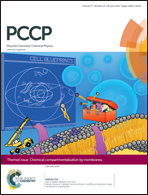Correlation of electrochromic properties and oxidation states in nanocrystalline tungsten trioxide†
Abstract
Although tungsten trioxide (WO3) has been extensively studied since its electrochromic properties were first discovered, the mechanism responsible for the coloration or bleaching effect is still disputed. New insights into the coloration mechanism of electrochromic, nanocrystalline WO3 are provided in this paper by studying thin WO3 films combining the electrochemical and spectroscopic techniques. By employing in situ UV-Vis transmission spectroscopy at a fixed spectral band pass during electrochemical experiments, such as cyclic voltammetry, a two-step insertion process for both protons and lithium ions is identified, of which one step exhibits a significantly higher coloration efficiency than the other. To obtain a better understanding of the insertion process AxWO3 (A = H, Li,…) thin films were studied at different stages of intercalation using UV-Vis and X-ray photoelectron spectroscopy. The results show that the first step of the intercalation process represents the reduction from initial W6+ to W5+ and the second step the reduction of W5+ to W4+. We found that the blue coloration of this nanocrystalline tungsten trioxide is mainly due to the presence of W4+ rather than that of W5+.


 Please wait while we load your content...
Please wait while we load your content...